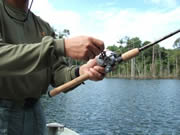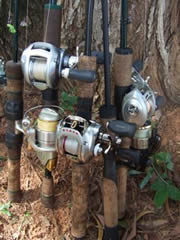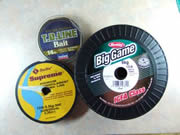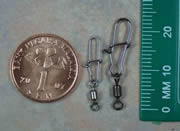 Strong Tackle for Sebarau - getting serious
Strong Tackle for Sebarau - getting serious
When sebarau (hampala barb) grow, not only do they grow longer but they also grow broader with more muscles and a bigger "vee" tail; therefore they have a lot more power. Thus snaggy areas need stronger tackle to be able to quickly wrestle away these stout sebarau from the snags where they probably are waiting in ambush. The tackle (e.g. hook, split ring, lure, snaps/swivel, line, rod and reel) must be beefy enough to keep its head turned away from the snag and headed to the boat.
Rods need to be stout, with a strong butt and midsection. Most good fast action rods fall within this category. A fast action rod is one that bends mostly in the upper one third of the rod. The reason why a fast action rod is a good tool to lever the sebarau out of the snags, is because when the rod is pumped or lifted, a stiff butt and mid section moves a lot more line, whereas a slow rod which flexes a lot throughout the whole rod when lifted, does not move much line because the whole rod bends, especially down to the fore grip.
The strength or line class of the rod is also a factor. A light rod may be fast action but if used to lift something heavier than it is designed for, it will in turn flex a lot at the mid and butt section (if it does not break first), no longer having the characteristic of a fast action rod. A heavy stick would have the best leverage but it will not be the best casting tool. So we end up back to the situation of looking for the best compromise.
There was a time when I was looking at having the most fun out of the sebarau I caught. My favourite outfit was a light 6-12 lb class fast action rod (with baitcasting reel) with a pistol grip rod. It was easy and comfortable to cast with. It also gave a good fight with sebarau of a kilo or less. In fact my biggest sebarau on that rod was 2.7 kgs, though where it was landed was not snaggy, making it easy to land.
Then there came one trip where I got thoroughly beat up on that outfit. We were working a narrow ravine where there were heaps of snags all along the sides and bottom of the submerged stream bed. We had twelve big hook ups (this does not include the many small sebarau caught that day) that session and we only managed to landed four! The four sebarau landed were in the 1.5 kg range and we could only make wild guesses how big the ones we lost were!
What would happen, as soon as the hook up occurred? If we could not turn the head of the sebarau to the boat and keep enough pressure to keep it coming, the sebarau would bury itself in the closest snag and that would be the end. The main problem was that the rods could not apply the pressure we wanted to exert on to the fish.
I soon returned with stronger rods. A stout 8-14 lb rod and a 12-20 lb rod. The lighter rod was about 5’ 10’’ with a 7’’ butt handle, and the heavier rod was 6’ long with a 10’’ butt handle. Both these rods had more lifting power, and with the longer butt handles I could plant them against my body or against my forearm to pump the rod with strength. (The pistol grip design is too short and does not give much physical assistance.)
This time I could successfully land the majority of the hook ups. The lighter rod was just sufficient to get the job done, while the heavier rod did it with ease. The preferred rod length when dealing with trophy sebarau in snaggy areas is 6 feet. A longer rod would give the sebarau the advantage of leverage against the angler.
The rod action should be fast so that the angler still has some stiff part of the rod to move some line and there should be some butt section below the reel to give the angler immediate leverage for pumping without having to change from the palming grip used during the lure retrieval to the fore grip. Any time wasted to change grip on the rod and reel in the early stages of the fight will give the sebarau the split second needed to turn and dive into the snags.
A fast action rod shorter than six feet makes a good fish fighting tool if it has similar criteria to the above. The only disadvantage of a shorter rod would be that the casting distance is reduced. However accuracy is increased and if fishing in a tight spot with a lot of over hanging trees (restrictive back swinging) and precise lure placement is required (i.e. small jungle river), this sort of rod would be ideal. Short rods that fit this criteria are not normally produced by the regular rod manufacturers, hence normally need to be custom built.
If fishing in the open waters of lakes or dams where there is plenty of space, having that extra casting distance gives one an edge, the longer 6’6” rods of similar line class and action are preferred.
The fast action rods ideal for sebarau fishing are commonly available these days. They vary in price, and what you pay for is what you get. The higher priced ones are lighter and have better quality components, but basically they all can get the job done.
The reels for this type of fishing would be the same type/size of spin reels as mentioned in the earlier article except the line and rod used should be heavier to deal with the increased drag used.
For baitcasters, any of the baitcasters that fit the palm are fine. As the lures used when going for bigger sebarau are heavier (they need strong hooks too) they are easier to cast and less demanding than the ultralight lures in terms of casting tackle requirements. However if the budget is available, the baitcasters capable of casting the lighter lures are nice to have. This is because many of the lures favoured by sebarau of all sizes border on the smallish side and life is easier with baitcasters that are easier to cast light lures.
Hampala Barb are often suckers for lures streaking past them, therefore reels with a fast retrieve, that is high gear ratio is the preferred option. For baitcasters, the retrieval gear ratio of above 6:1 is considered fast and does a good job of getting the sebarau’s hit the lure instinct aroused.
I remember one instance where my friend and I were fishing from the same canoe and using the same lures. The sebarau were busting the water all around us and initially we could not get a single bite. I had just cast out a lure and was retrieving it in. Then suddenly behind me a sebarau gave a big splash.
I retrieved the lure as fast as I could to get a cast out at the feeding sebarau behind me. When I speeded up my retrieval rate to maximum speed a sebarau took my lure. Putting two and two together, I started hooking up several sebarau by cranking as fast as I could. My friend did the same thing but could not get a single bite. Later we realised it was because he was using a reel with a slow gear ratio. No matter how fast he could humanly crank, it just was not fast enough.
Although the rod is the primary tool to move the line during the pumping action, having one of the new baitcasting reels with oversized main gears is nice to have. Not a necessity, but it is nice to have a little extra power there on the down crank when the rod is lowered to keep the pressure on. This is especially useful in extreme territory, the kind where there are severe snags every where!
When not trying to cast ultra light lures, braided line of 12 - 18 lb is a good general line to use. It is fine enough to get lures deep and also has enough abrasion resistance to handle most situations a main line would encounter. Lighter braid is not an issue so long as more time is spent on maintenance, looking for wear and tear on the line, cutting off worn or nicked line and careful use of knots to join the leader. Heavier braided lines give a nice reserve of strength against wear and tear, but there is a loss of depth due to the thicker line.
Coated or fused superlines are thicker than braided superlines, so 10 - 14 lb class will give a thin enough diameter for achieving depth and ease of casting. Like the lighter line classes of this type of line, the actual strength of superlines is often double that of those on the label, if used correctly.
If monofilament mainline is used, probably 12 lb is a good compromise, giving some good resistance to abrasion and not too thick to affect casting distance for a spin reel, and the depth the lure can dive down. Thinner would be better but we do not want too much reduction in line strength or abrasion resistance. It may be needed when encountering a monster sebarau.
Mono leaders are recommended for superlines for shock protection and more line invisibility than having the superline attached straight to the lure. For the mono mainline, a leader is also preferred, especially in snaggy territories. A leader of 20 lb provides adequate abrasion resistance in most circumstances and is good for general use. Lighter leaders make life more risky, but is OK in open waters.
Heavier leaders spook shy fish and dampen the lure action, but may be necessary in extreme snag territory. It is a struggle to decide how heavy a leader should be used when fishing difficult waters. Recently I lost two big sebarau that cut me off in less than two seconds. I was using 20 lb fluorocarbon leader. I am still undecided whether to go heavier to a 40 lb leader as the bites normally taper off the heavier the leader used because of the increased visibility and presence of the leader and the reduction in lure action. So the quandary is, is it better to have a hook up and lost the fish, but have had the thrill, or felt nothing at all and kept the lure?
The snaps and swivels for the heavier sebarau tackle are only a little bigger and stronger than those recommended for the light spin gear. It is because too big a snap/swivel will affect the smaller lures that sebarau of all sizes love, the 5-7 cm lures. The swivel size 8 and snap of 15 mm need to be strong and tough. Go for the good quality ones that will not fail under pressure. Quality goes hand in hand with monetary value but realistically in the overall picture of fishing expenditure for small items like these it does not amount to much in the long run.
Foregoing the use of snaps and swivels is an option but for spin gear line twist can be a problem. For baitcasting gear, line twist can be a problem if lures that spin (like spinners) are used. Snaps and swivels also come in useful to recover snagged lures that cannot be jiggled loose as some of the lure retrievers loop on the the swivel during the retrieval process to “hook” onto the snagged lure.
If the leader is tied directly to the lure, using a loop type knot will give the lure the best action as the loose loop allows the lure more freedom to wiggle freely than a knot cinched down tight around the tow point. Not using a snap and swivel is also two less pieces of terminal tackle to fail, but the changing of lures is slower when the leader needs to be cut and retied.
The majority of the lures that work so effectively for sebarau in Malaysia were not designed with sebarau in mind, so the hooks on these lures need to be upgraded to something tougher. Many an angler has hooked on to something “big” and then lose the fish and retrieve the discarded lure with its hooks opened up.
For its size, the sebarau hits hard and fights like there is no tomorrow (With catch and release anglers a rarity out there, they should fight like there is no tomorrow!). That means, to catch trophy sebarau on a consistent basis, every big hook up must be made to count, and not become another story of the one that straightened the hooks.
The hooks should be able to withstand the stress it will encounter. Heavier hooks and split rings used to upgrade the lure should not be blindly put on but the ability of the lure to take the heavier hardware should be considered. Some lures are “delicate” things and lose all swimming action when hardware heavier than they are designed for are put on. So upgrade the hooks accordingly allowing the lure to still show its best action. Alternatively, choose your sebarau lures according to their ability to take hardware upgrades.
Having the right tackle enhances the fishing experience and also puts the angler in a better position of catching the sebarau. However bear in mind, that the fishing tackle are only tools to be used with skill in our hands and it is the person who wields the tool that will catch the sebarau. Tackle used properly is a joy to use, and of course one has to fish where there are sebarau too!
Conservation


We need to protect and conserve our resources by practising catch and release of our sportfish and protecting the habitat of our fishes.














